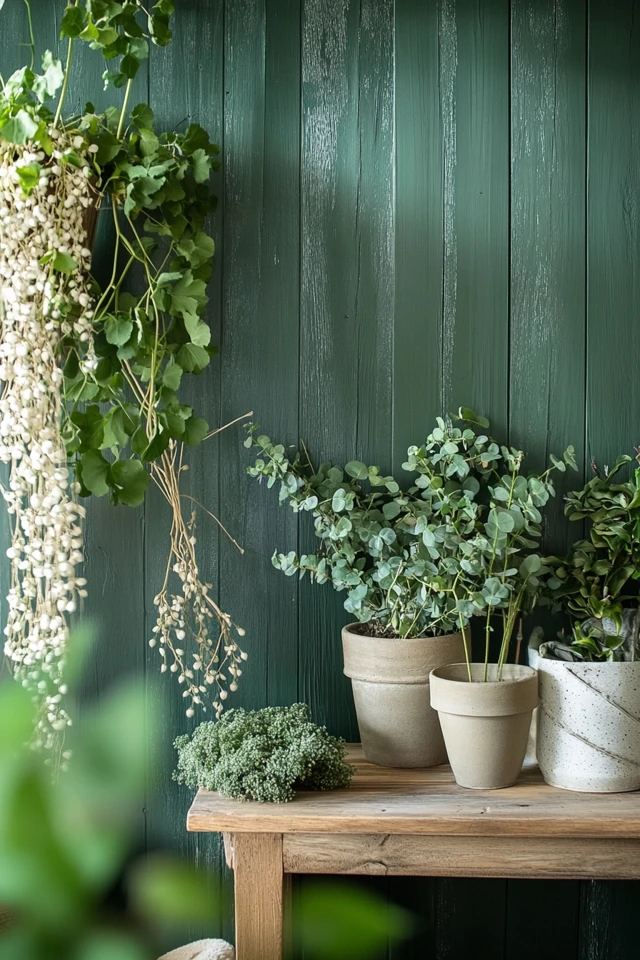Introduction
I’ll never forget the first time I walked into a farmhouse-style living room that truly took my breath away. The space was a vision of soft neutrals, rustic wood, and charming accents. But the real star? A sprawling fiddle leaf fig in the corner, paired with smaller pots of cascading ivy and a bundle of eucalyptus stems resting in a vintage jug. That greenery brought the room to life, giving it a fresh, vibrant energy that no paint color or furniture piece could replicate.
In my years as an interior designer, I’ve learned that greenery isn’t just an accessory in farmhouse décor—it’s a necessity. Adding plants, both real and faux, can transform a space from static to serene. Greenery plays an essential role in softening the edges of farmhouse style, introducing natural elements that complement rustic wood finishes, galvanized metals, and cozy textiles.
If you’ve ever wondered why greenery is such a prominent feature in farmhouse design or how to incorporate it into your space, you’re in for a treat. Today, we’ll explore the role greenery plays in farmhouse décor and how you can use it to elevate your home’s style.
Why Greenery is Essential in Farmhouse Décor
1. Bringing Nature Indoors
Farmhouse style is deeply rooted in the idea of connecting with nature. Greenery helps bring the outdoors in, creating a harmonious balance between your home and the natural world.
- Connection to Simplicity: The rustic charm of farmhouse décor is all about simplicity and authenticity. Plants—whether wildflowers in a mason jar or a potted fern—enhance this sense of organic beauty.
2. Adding Life and Energy
No matter how beautifully designed a room is, it can feel lifeless without the addition of greenery. Plants breathe life into a space, quite literally, by purifying the air and creating a sense of vibrancy.
- Visual Energy: Greenery introduces movement and texture, breaking up the monotony of neutral tones.
- Emotional Impact: Studies have shown that being surrounded by plants can reduce stress and boost mood—a perfect complement to the cozy vibes of farmhouse style.
3. Providing Color and Contrast
Farmhouse interiors often rely on neutral palettes, which can sometimes feel flat. Greenery adds a splash of color without clashing, as its natural tones complement any scheme.
Choosing the Right Greenery for Your Farmhouse
Real vs. Faux Plants
One of the first decisions you’ll need to make is whether to go with live plants or faux options. Here’s how to decide:
- Real Plants: Ideal if you love caring for greenery and want the benefits of air purification.
- Popular Choices:
- Fiddle Leaf Fig
- Snake Plant
- Pothos
- Ferns
- Best for: Those who have time to water and maintain their plants.
- Popular Choices:
- Faux Plants: A fantastic alternative if you lack a green thumb or prefer a no-maintenance solution.
- Popular Choices:
- Faux eucalyptus stems
- Artificial olive trees
- Preserved moss
- Best for: Busy homeowners or rooms with little natural light.
- Popular Choices:
Types of Greenery to Use
- Large Statement Plants
- Examples: Fiddle leaf fig, olive tree, rubber plant
- Best Locations: Corners of living rooms, next to furniture, or as focal points in entryways.
- Trailing and Cascading Plants
- Examples: String of pearls, pothos, ivy
- Best Locations: Hanging planters, shelves, or over the edges of cabinets.
- Small Accents
- Examples: Mini succulents, small potted herbs
- Best Locations: Coffee tables, kitchen counters, or windowsills.
- Cut Greenery and Stems
- Examples: Eucalyptus, pampas grass, wildflowers
- Best Locations: Vases, pitchers, or jars on dining tables, mantels, or sideboards.
Incorporating Greenery Into Farmhouse Design
1. Pair Greenery with Rustic Containers
Farmhouse style thrives on repurposing everyday objects, so think beyond traditional pots:
- Mason jars, galvanized buckets, and vintage milk cans make charming planters.
- Wooden crates or baskets can hold multiple potted plants for a layered effect.
2. Use Greenery to Enhance Key Features
Strategically place plants to draw attention to architectural details or design elements.
- Wrap a garland of faux greenery around an exposed beam.
- Place cascading plants on open shelving to soften the hard edges.
3. Create Centerpieces with Greenery
Greenery makes for beautiful, low-maintenance centerpieces:
- Combine eucalyptus and white flowers in a metal pitcher for a farmhouse dining table.
- Add a potted herb trio (like basil, rosemary, and thyme) to a wooden tray for your kitchen island.
Picture Gallery
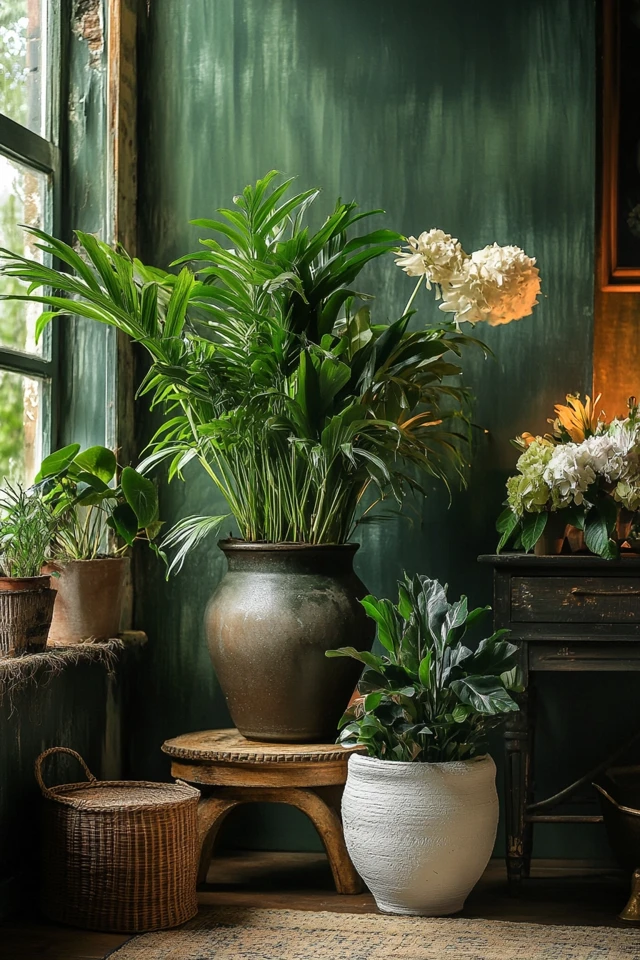
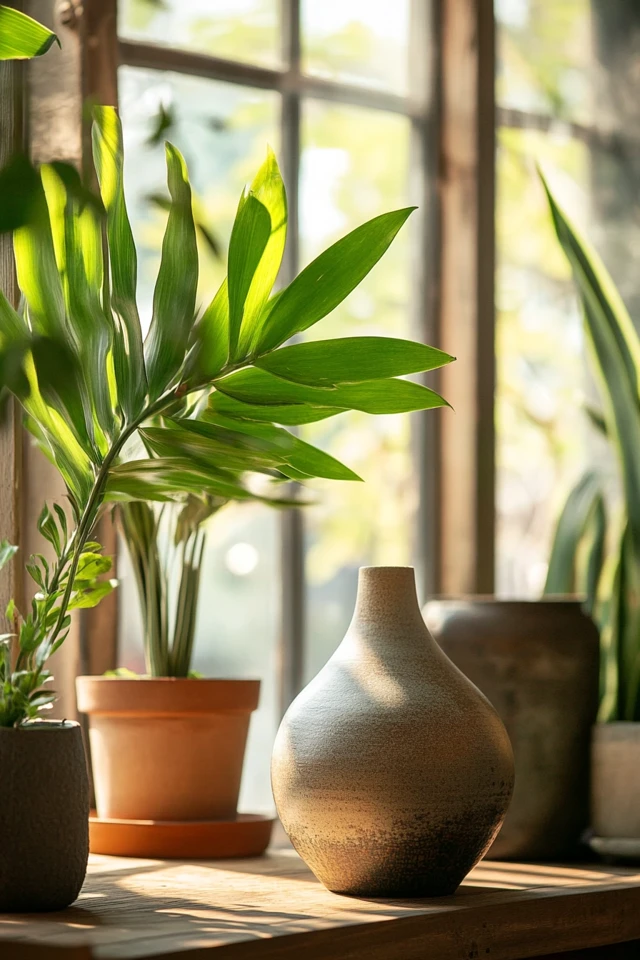
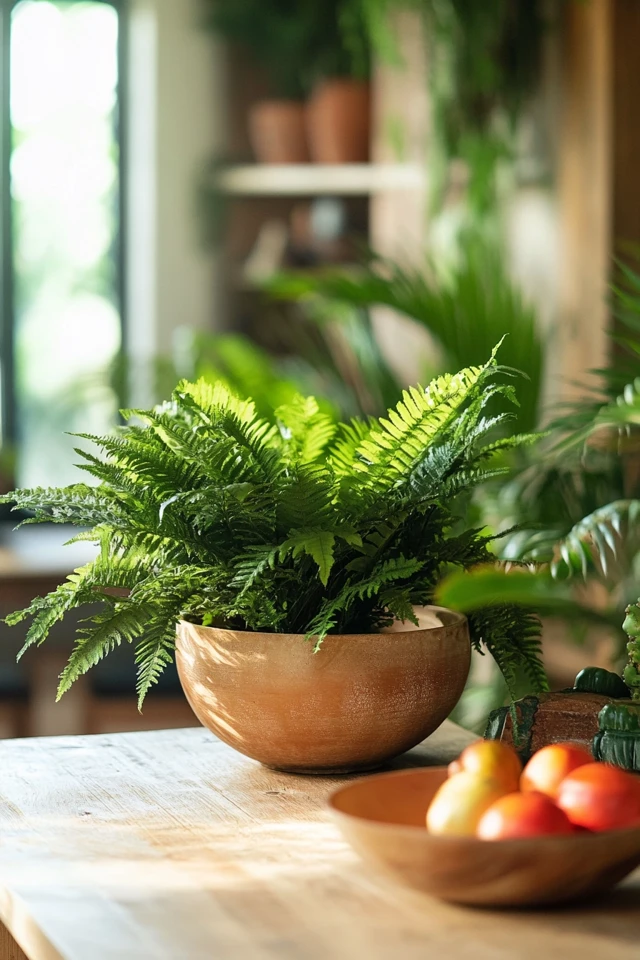
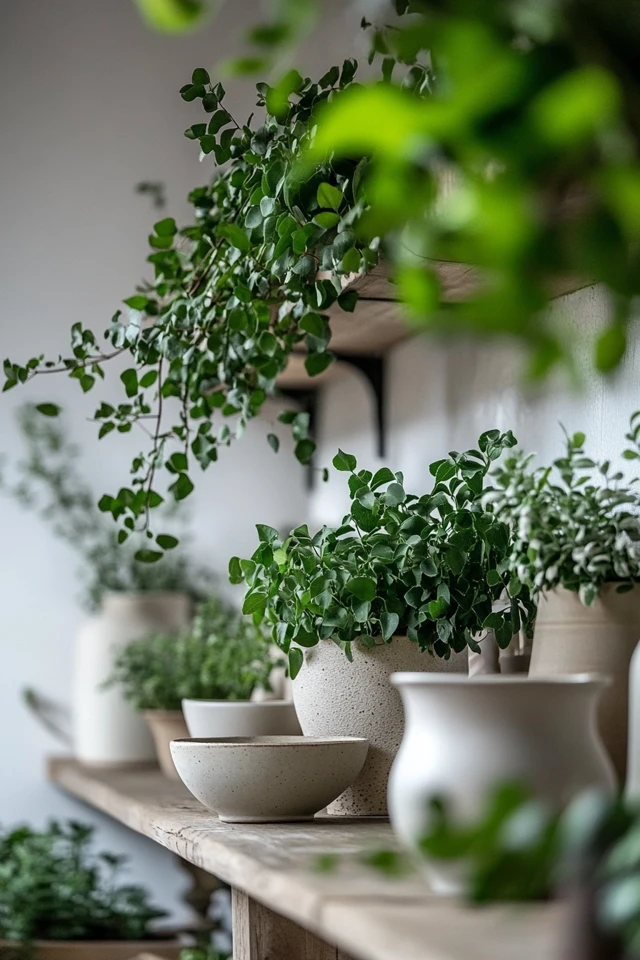
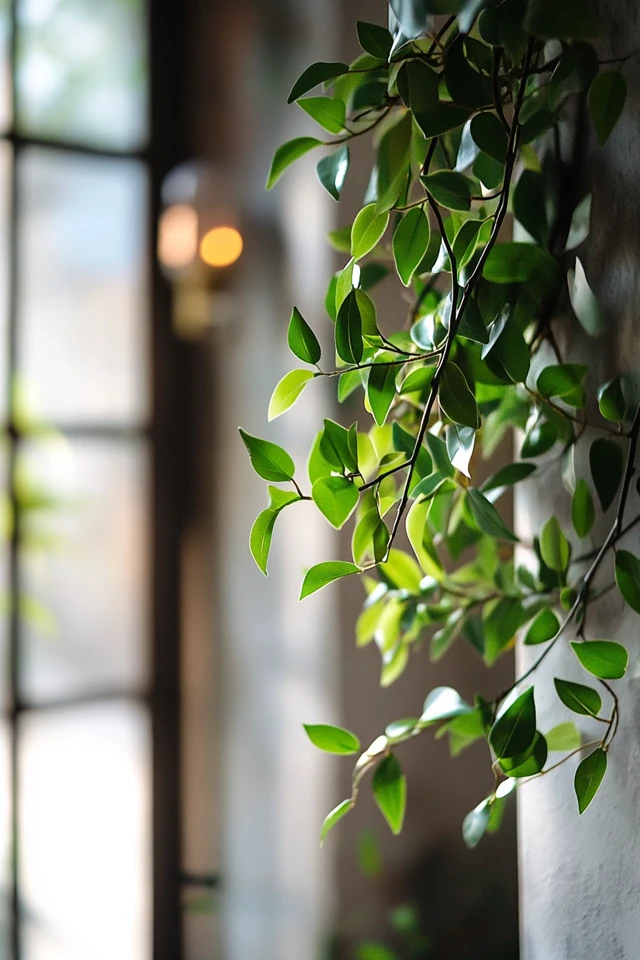
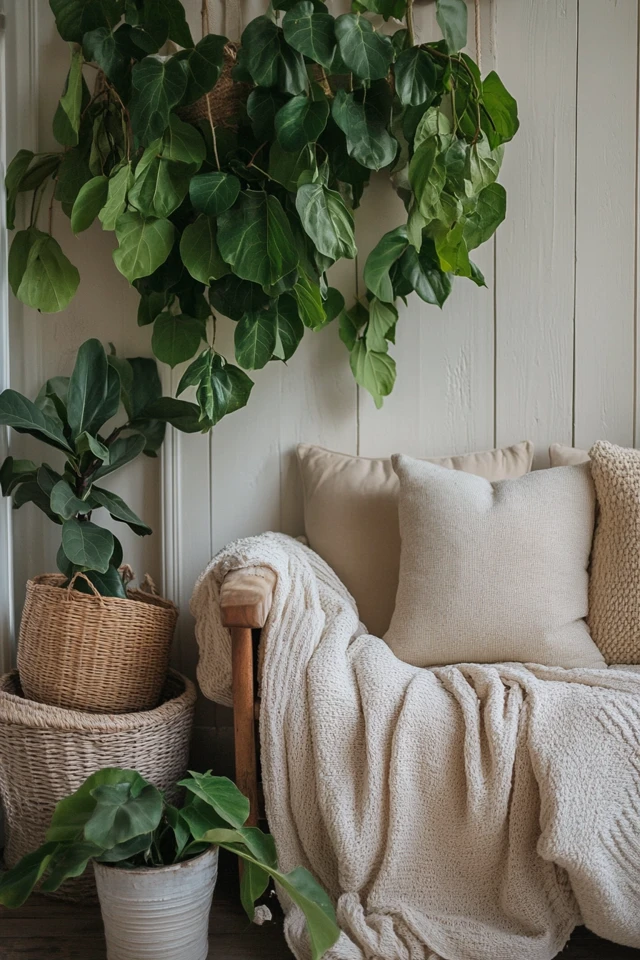
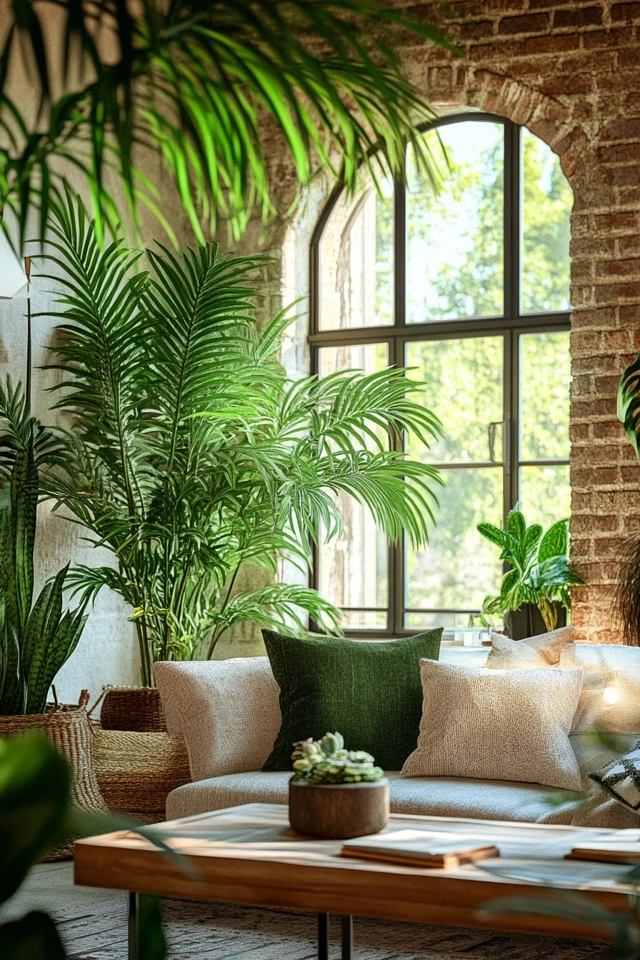
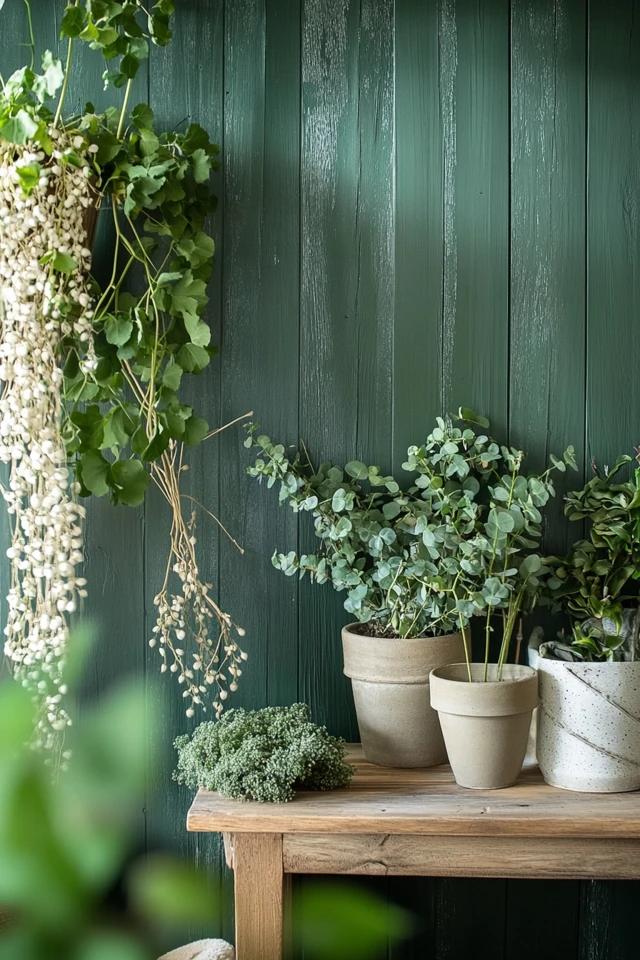
Seasonal Greenery Ideas
One of the joys of incorporating greenery into farmhouse décor is its versatility. You can easily update your arrangements to reflect the seasons:
Spring
- Add blooming branches like cherry blossoms or dogwood.
- Pair bright green foliage with pastel accents.
Summer
- Use lush, tropical-inspired plants like ferns and monstera leaves.
- Incorporate wildflowers for a casual, fresh-from-the-meadow vibe.
Fall
- Add dried grasses like pampas and wheat stalks to your arrangements.
- Use muted greens paired with autumnal colors like burnt orange and deep red.
Winter
- Use evergreen branches, pinecones, and holly for holiday arrangements.
- Opt for simple greenery in glass jars for a minimalist winter look.
Greenery Care Tips for Beginners
If you’re new to incorporating real plants, here are some tips to keep them thriving:
- Lighting: Know the light requirements of your plants and place them accordingly.
- Watering: Avoid overwatering; most plants prefer their soil to dry out slightly between waterings.
- Dusting: Wipe down leaves occasionally to keep them looking fresh and healthy.
- Rotation: Rotate potted plants every few weeks to ensure even growth.
For faux plants, simply dust them regularly and rearrange them seasonally for variety.
Conclusion
Greenery plays an irreplaceable role in farmhouse décor, bringing life, warmth, and a touch of nature to your space. Whether you prefer the authenticity of real plants or the convenience of faux greenery, adding foliage is one of the simplest ways to elevate your home’s aesthetic.
Personally, I’ve found that greenery is like the finishing touch on a painting—it ties everything together. My own home is dotted with plants: a cascading pothos here, a bundle of eucalyptus there, and a tall fiddle leaf fig that always earns compliments from visitors. It’s these touches of green that make the space feel truly alive.
So, if you’re ready to bring your farmhouse vision to life, don’t forget the plants! Start small with a vase of greenery on your dining table or go bold with a statement plant in your living room. Whatever you choose, you’ll find that greenery is the secret ingredient to farmhouse style that feels fresh, vibrant, and timeless.
FAQ
What types of greenery work best for farmhouse décor?
Fiddle leaf figs, olive trees, pothos, and eucalyptus stems are popular choices. Dried grasses like pampas also work beautifully in rustic arrangements.
Can I use faux plants in farmhouse décor?
Absolutely! Faux greenery is a great option if you prefer low-maintenance décor. Just choose high-quality faux plants for a realistic look.
How do I style greenery in a farmhouse kitchen?
Use small potted herbs on countertops or windowsills, and display a vase of eucalyptus or wildflowers on your island or dining table.
What containers are best for farmhouse greenery?
Rustic containers like mason jars, galvanized buckets, wooden crates, and ceramic pots complement farmhouse style perfectly.
How do I keep real plants alive if I’m not a plant expert?
Choose low-maintenance plants like pothos or snake plants, place them in suitable lighting, and water sparingly to avoid overwatering.

